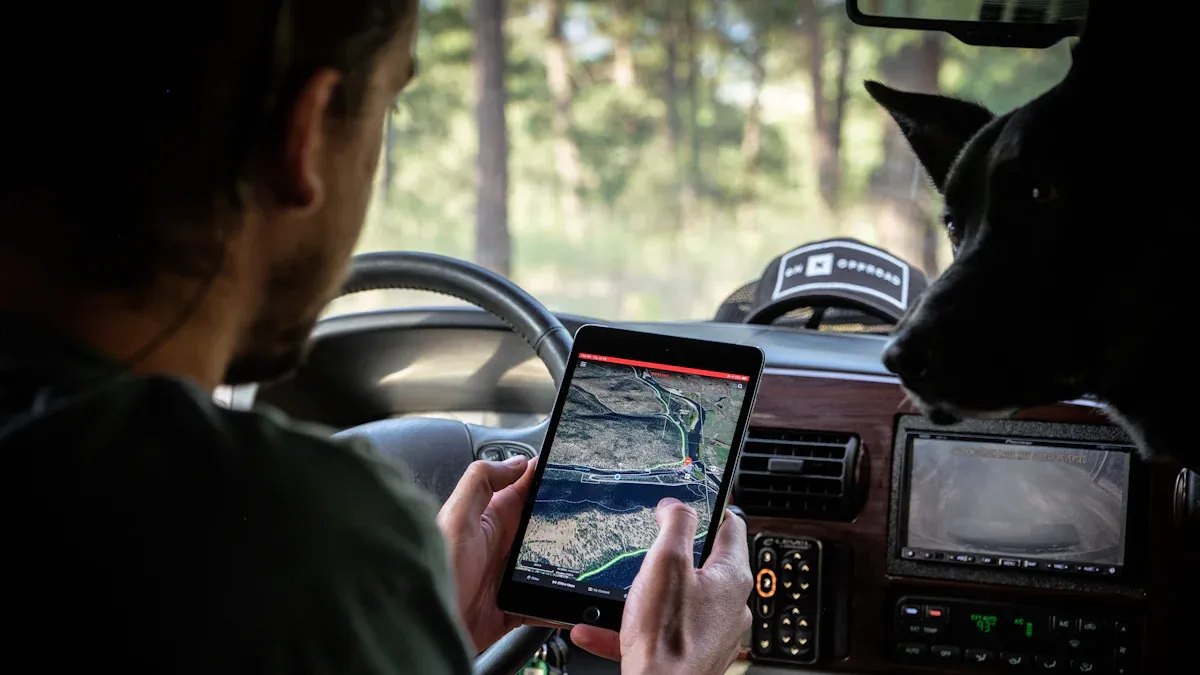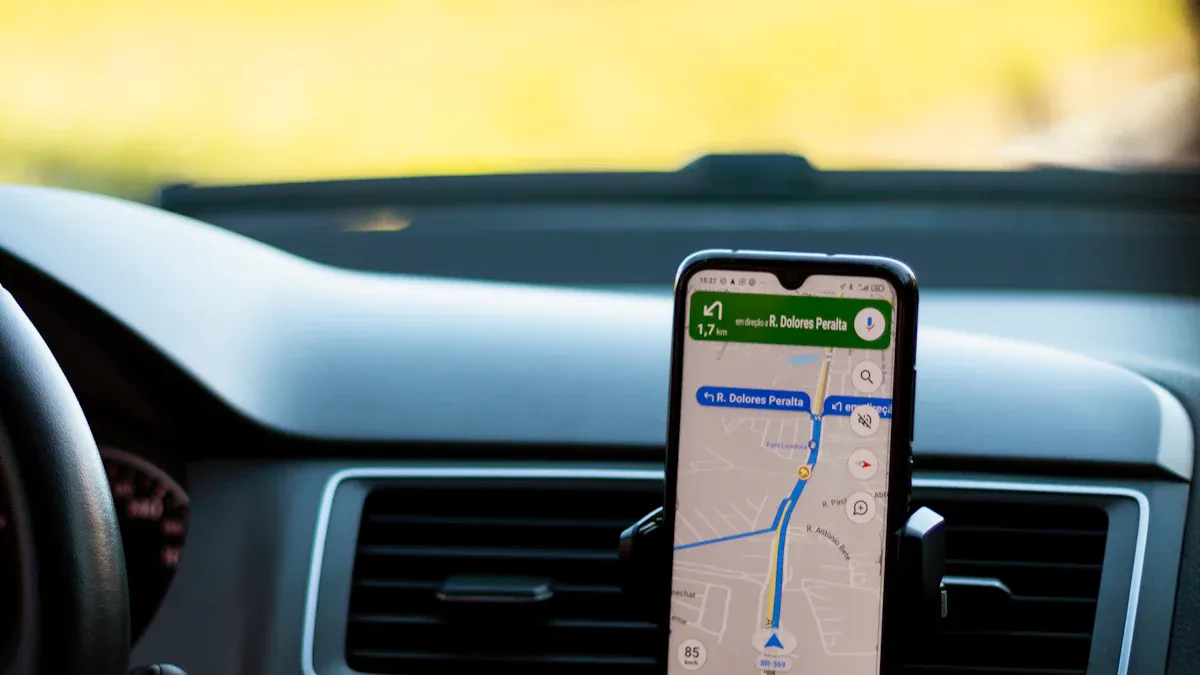
You can use real-time GPS taxi ad content scheduling to show changing and targeted messages as taxis move in the city. Real-time data helps you quickly change ads based on where the taxi is, what time it is, or even the weather. Advertisers get more people to notice their ads, like 20% of people scan QR codes, and brands become more visible. Passengers get special offers just for them and enjoy smoother rides.
Taxi ads reach many people with real-time alerts all day and night, leading to clear results like a 15% jump in Broadway ticket sales and a 30% boost in coffee shop visits.
Real-time alerts help show ads that fit the moment, making brands stronger and passengers happier.
Key Takeaways
Real-time GPS data helps taxi ads change fast. Ads can change based on where the taxi is, what time it is, and the weather. This helps ads reach the right people at the best time.
Dynamic ad displays and content management software help update ads from far away. They show special messages that get people’s attention.
Geofencing makes pretend zones to start ads for certain places. This helps advertisers show ads in busy spots like airports and malls.
Using analytics and predictive scheduling helps plan ads before time. This makes ads work better by matching them to busy roads and times.
Keeping passenger privacy safe with strong security and rules builds trust. It also helps ad campaigns stay correct and work well.
Real-Time GPS Taxi Ad Content Scheduling

What It Is
Real-time gps taxi ad content scheduling lets ads change as taxis move. The system uses gps taxi advertising to find where each taxi is. It sends ads that fit the area, time, or weather. Real-time data helps you change ads right away. This means you can reach the right people at the best time. Old ways used fixed schedules and could not update fast. Now, you can control ads with live information. AI and automation make scheduling simple and correct. The system looks at rider profiles and trip routes. It picks the best ad for each moment. You see ads that match your trip. Advertisers reach people who may care about the ad.
Tip: Real-time gps taxi ad content scheduling stops wasted ad space. Ads only show when and where they matter most.
Why It Matters
Using gps taxi advertising with real-time data gives many benefits. Both advertisers and taxi operators get better results. Here are some reasons why real-time gps taxi ad content scheduling is important:
Advertisers can change ads fast by time, place, or goals. This helps you reach more people.
Dynamic LED displays on taxis get more attention than old ads. More people notice and care.
Real-time analytics show how many people see and use each ad. You can use this to make your ads better.
You can control and update ads from your phone or computer. This makes it easy to target the right place and time.
GPS taxi advertising lets you send ads for local events or times. You reach people who want what you offer.
Taxi operators save money with LED displays that need little work. Remote management keeps ads running well.
The system tracks which ads play and when. You can see what works best and change your plan for more profit.
You get more people and sales with real-time gps taxi ad content scheduling. For example, a restaurant chain used gps taxi advertising near their stores. They saw more customers during busy times. Real-time data and smart scheduling help you get the most from every taxi ride.
Key Components
GPS Tracking Devices
You need good GPS tracking devices for gps taxi advertising. These devices have a GPS module, GSM module, and microcontrollers. They help you know where each taxi is right now. The system sends this information to a vehicle tracking system. You can see real-time gps tracking for every taxi in your group. This setup lets you find any taxi at any time. You can use a battery and adapter to keep the devices working. Real-time tracking gives you quick updates, so you can manage taxis better.
Note: Real-time gps tracking lets you see your taxis live. You can view your whole fleet on one screen.
Dynamic Ad Displays
Dynamic ad displays make gps taxi advertising work better. These screens are inside or outside the taxi. They show ads that change with real-time gps tracking. When a taxi goes to a new place, the display shows local ads or news. The system uses Wi-Fi or cellular to update in real time. Some displays have touch screens or QR codes. Passengers can use the ads or get more details. This makes taxi rides more fun.
Dynamic displays use GPS to show the right ads.
You can show local deals, weather, or news.
The system changes ads right away as the taxi moves.
Content Management Software
You control your ads with content management software. This cloud system lets you upload, plan, and change ads for each taxi. You can set rules for when and where ads show up. The software uses real-time gps tracking to match ads to each taxi’s spot. You get reports on how ads do and can change your plan. Security tools like encryption and access control keep your data safe.
Component Type | Essential Components | Description |
|---|---|---|
Hardware | GPS receiver | Finds taxi location in 3D using satellites. |
In-cab display unit | Shows ads or info to passengers and drivers. | |
Software | Offers real-time tracking, mapping, and reporting. | |
Security features | Protects data with encryption and authentication. | |
Backend infrastructure | Supports many taxis and large data streams. |
Fleet Management Integration
Fleet management integration links gps taxi advertising to your whole business. You can connect the system to your taxi booking app integration. This helps you track taxis, plan schedules, and change ads from one place. Real-time monitoring lets you find problems fast. You can use fleet management to see your taxis and keep them working well. Taxi booking app integration also lets you send special deals to passengers when they book rides. You get more control and make more money with this system.
Fleet management tools help you track fuel, repairs, and routes.
Taxi booking app integration helps you connect with passengers.
You can manage all taxis and ads from one dashboard.
Scheduling Process

Real-Time Data Integration
You need strong real-time data integration for taxi ad scheduling. Real-time gps tracking sends live location data from each taxi. This helps you know where every taxi is right now. You can use tools like Google Maps API or Mapbox for maps. These tools help you get accurate locations. Backend systems like Node.js or Python process this data. They send it to your scheduling dashboard. The front end shows updates so you see taxis move on the map.
Algorithms like Kalman filters keep your data correct. These filters smooth out GPS data and fix mistakes. Real-time gps tracking lets you share locations and calculate ETAs. It also helps you make routes better. These features help you send the right ads at the right time. You can use real-time alerts to tell drivers or passengers about new ads.
Tip: Real-time tracking integration helps you work faster and makes ad scheduling smarter.
Here is a table that shows the technical parts you need for real-time data integration in gps taxi advertising:
Technical Component / Technology | Purpose / Function |
|---|---|
Backend Infrastructure | Scalable, secure backend to keep data safe, check users, and connect with other services (maps, payments) |
Real-Time Data Processing | Manage GPS and ride data for live updates and tracking |
API Integrations | Connect with maps, payment gateways, notifications, and analytics |
Frontend Frameworks | React Native, Flutter for mobile apps; Swift, Kotlin for native apps |
Backend Frameworks | Node.js/Express.js and Django/Python for APIs, business logic, and scaling |
Databases | PostgreSQL, MySQL for regular data; MongoDB for flexible NoSQL storage |
Real-Time Features | Firebase, Socket.IO for live location tracking and updates |
Maps & Navigation APIs | Google Maps API, Mapbox for GPS, geolocation, directions, and ETA calculations |
Payment Gateways | Stripe, PayPal, Razorpay for safe online payments and wallet use |
Push Notifications | Firebase Cloud Messaging (FCM) for alerts on bookings and driver arrival |
Authentication | OAuth 2.0, Firebase Auth for safe user login and session management |
Geofencing and Location Triggers
Geofencing helps you show ads to people in the right place. You set up virtual boundaries around busy spots like airports or city centers. When a taxi enters or leaves these zones, the system uses real-time gps tracking to show location-based ads. This uses real-time event triggering to send ad schedules and alerts.
Here is how geofencing and location triggers work for taxi ad scheduling:
Draw a virtual boundary around a busy place, like a mall or stadium.
Ask users for permission to use their location in your taxi booking app.
Track when a taxi enters or leaves the geofenced area with real-time gps tracking.
Send alerts, like push notifications or in-taxi ads, when the boundary is crossed.
Group your audience by age, interests, or travel habits to show the best ads.
Send timely offers or ads to passengers’ devices to get more engagement and ride requests.
Note: Geofencing lets you target people nearby, so your ads reach those most likely to respond.
To set up geofencing in gps taxi advertising, make clear boundaries, use simple triggers, and write easy ad messages. Watch your campaigns and change your schedule for better results. Companies like Uber use geofencing to send alerts and in-app ads near airports and hotels. This shows how well this method works.
Adaptive GPS Taxi Advertising
Adaptive gps taxi advertising changes ads as taxis move using real-time data. You can update ads as taxis drive through different neighborhoods. This uses route optimization to match ads to the area, time, and people. You can add interactive features like QR codes for deals or more info.
You measure success by tracking how many people see and use your ads. Real-time alerts and updates help you change your campaigns fast. You can change your message based on what works best. Adaptive gps taxi advertising gives you more brand visibility and higher engagement than static ads. In busy cities, this method connects you with thousands of people each day.
Adaptive ads use real-time gps tracking and route optimization to reach the right people.
You can update ads right away as taxis move.
Real-time alerts and interactive features get more people interested.
You get better tracking and results than with static ads.
Predictive Scheduling with Analytics
Predictive scheduling uses analytics and real-time data to plan taxi ads early. You look at old trips, traffic, and rider habits to guess where taxis will go next. This helps you set up automatic ad schedules for future needs. You use route optimization to pick the best times and places for ads.
Smart scheduling tools study real-time gps tracking and fleet management data. They help you send alerts when things change, like traffic jams or big events. You can use taxi booking app integration to send special offers to passengers before they get in the taxi.
Pro Tip: Predictive scheduling with analytics helps you plan ads for busy times and popular routes.
With predictive scheduling, you get more from your gps taxi advertising. You reach more people, save money, and get better campaign results. Real-time updates and automatic ad schedules keep your ads fresh and useful, no matter where your taxis go.
Best Practices
Targeting and Personalization
You can use real-time GPS data from taxis to target ads better. This data shows where each taxi is right now. It helps you split your audience and update user profiles as they move. When you link this data with CRM and behavior signals, you can show ads that match the passenger’s location and what they want. Machine learning and IoT tools help you study these data streams. You can send ads that fit each moment. You can also make landing pages and offers special for each ride. Route optimization helps you pick the best routes for ads. This way, you reach people who are most likely to respond. Real-time alerts let you change ads fast. This keeps your campaigns fresh and important.
Tip: Make your ads personal so passengers notice them in every taxi.
Compliance and Privacy
You must keep passenger data safe when using real-time GPS for taxi ads. Privacy rules say you need special ways to protect data. The table below explains how privacy compliance works for taxi ad scheduling:
Aspect | Description | Impact on Real-Time GPS Taxi Ad Scheduling |
|---|---|---|
Privacy Compliance Methods | Use federated learning, differential privacy, and collaborative learning to keep GPS and trip data private. Adding noise and combining model results helps protect privacy. | Limits how you share data and train models, so you need privacy-safe systems. |
Performance Trade-off | Differential privacy adds noise, which can lower prediction accuracy. Collaborative learning and clustering help fix problems with different data types. | May change how fast, accurate, and personal your ad scheduling is because of privacy rules. |
System Architecture | CC-Net uses federated learning with clustering and contrastive learning. This helps keep predictions accurate and private. It is tested against privacy attacks. | Lets you predict taxi demand well without sharing raw data. This follows privacy laws but can make things more complex and slower. |
Empirical Results | Tested on real data from five taxi companies over 14 months. It got 2.2% better accuracy than systems that share data. It is strong against privacy attacks. | Shows privacy-safe systems can still be accurate. This is important for good real-time ad scheduling with GPS data. |
You should always use privacy tools to keep passenger trust and follow the law.
Maximizing ROI
You can get more value from your taxi ad campaigns by using smart steps:
Use real-time GPS tracking to change ads based on taxi location and audience.
Pick dynamic LED displays for quick ad changes and bright messages.
Make ads more personal with geofencing, AI analytics, and route optimization.
Link your system with taxi booking apps for more reach and easy scheduling.
Track results with analytics, A/B testing, and real-time alerts.
Change ads during busy times or near popular places to get more attention.
Watch your costs by choosing the best hardware and software for your business size.
Work with providers who give good support and flexible contracts.
You can also count impressions and routes to see how your ads work. Use CPM to compare costs and plan your budget. Study local likes to make better ads and grow your brand.
You gain better targeting and smoother operations with real-time GPS taxi ad scheduling. You see alerts for every key event, like taxi location changes or ad updates. Alerts help you act fast and keep your campaigns fresh. Alerts show you when taxis enter busy areas, so you can switch ads right away. Alerts let you track campaign results and adjust your strategy. Alerts remind you to check hardware and software health. Alerts guide you to follow local rules and keep your system safe. Alerts help you manage power and avoid battery drain. Alerts connect you with support teams for quick fixes. Alerts give you real-time feedback to improve your ads. Alerts make your taxi ad system smarter and more effective.
Ready to start? Follow these steps:
Check local laws for taxi top displays.
Pick hardware with GPS and network support.
Use a cloud CMS for remote ad scheduling.
Install displays safely and securely.
Add power management to protect your taxi.
Use CMS analytics and alerts to track campaigns.
Contact your supplier for custom options and support.
You can boost your brand and reach more people by using alerts and real-time GPS taxi ad scheduling. Try a platform or ask for a demo to see how alerts can help your business grow.
FAQ
How does real-time GPS data improve taxi ad targeting?
Real-time GPS data helps you show ads in the right spot. You can reach people when your taxi is close to them. You can also change ads fast for local events or busy places.
Can you control taxi ads remotely?
You can control taxi ads from your phone or computer. The content management software lets you update or stop ads anytime. You do not need to be near the taxi to make changes.
What is geofencing in taxi advertising?
Geofencing makes a virtual line around a place. When your taxi goes in or out, the system shows special ads. You can send messages to people near airports, malls, or events.
Is passenger data safe with GPS taxi ad systems?
Passenger data stays safe with privacy tools like encryption and secure logins. The system follows privacy rules and protects personal info. Keeping data private helps build trust.
See Also
Best CarPlay Devices For VW Golf Drivers In 2025
Guide To Using CarPlay For Streaming And Browsing Safely
Reviewed Best Motorcycle GPS Units Featuring CarPlay And Android
